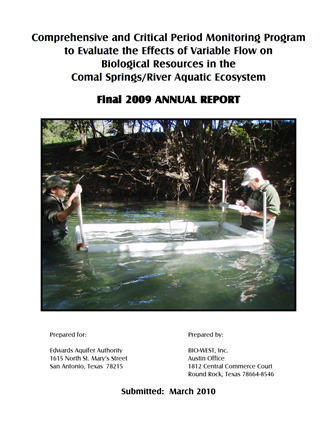Comprehensive and Critical Period Monitoring Program to Evaluate the Effects of Variable Flow on Biological Resources in the Comal Springs/River Aquatic Ecosystem Final 2009 Annual Report

| Summary |
|
The purpose of this report is to document the results of all aquatic ecosystem monitoring conducted in 2009 at San Marcos Springs located in San Marcos, Texas. The monitoring and report preparation was performed by BIO-WEST, Inc. Pflugerville, Texas. [Excerpted from the Executive Summary] The variable flows of 2009 had a myriad of effects on the aquatic vegetation in all reaches. … Fountain darter abundance in the Comal River was again variable in 2009, but within the range of previous years observed throughout this study. … In areas near spring upwellings with native vegetation (e.g., bryophytes) there appears to be year-round reproduction. However, dip net data confirm an early spring reproductive peak for these fish in other areas of lower quality habitat. … Although the total number of Comal Springs riffle beetles (Heterelmis comalensis) captured decreased slightly from 2008 to 2009, numbers were similar to those observed in 2007. … The total number of salamanders observed during the spring and Critical Period sampling efforts were the highest since the inception of the study…. Flows from Comal Springs in 2009 were the lowest observed since 2000, but impacts on the biota in the ecosystem appeared to be minimal. Continued monitoring over an extended period of lower than average flows is necessary to fully understand the impact of discharge on the varied biota in the system. |
Search for Documents
Advance Search
Explore EAA's Scientific Reports
- All Reports
- Water Resources Planning and Management
- Floods and Drought
- Water Quality
- Climatology
- Surface Water / Groundwater Relationship
- Biology
- Springs, Groundwater Discharge
- Archaeology
- RZ Protection
- Aquifer Levels
- Remote Sensing
- Precipitation
- Overview Studies
- Modeling
- Hydrology and Hydrogeology
- History
- Groundwater Recharge, Recharge Zone
- Groundwater Movement
- Geomorphology and Caves
- Weather Modification
- Geology
- Water Use and Conservation
- Geochemistry
